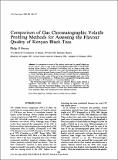| dc.description.abstract | A comparison is made of the various ratios used to quantify black tea
aroma such as the ratio of the sum of gas chromatographic peak areas of compounds
eluting before linalool (3,7-dimethyl-1,6-0ctadien-3-01) to those eluting after
linalool (Wickremasinghe-Yamanishi ratio); gas chromatographic peak areas of
compounds imparting sweet flowery aroma (Group I1 volatile flavour compounds)
to those imparting green grassy aroma (Group I volatile flavour compounds),
Owuor’s flavour index; ratio of the sum of the gas chromatographic peak area of the
terpenoids to non-terpenoids, i.e. Mahanta ratio; and gas chromatographic peak
area of linalool to E-2-hexena1, i.e. Yamanishi-Botheju ratio.
The Wickremasinghe-Yamanishi ratio and Owuor’s flavour index showed a
significant relationship, the Mahanta ratio showed a significant but poor
relationship, and the Yamanishi-Botheju ratio had no relationship with the
tasters’ evaluation of Kenyan clonal CTC black teas. Similar results were obtained
from orthodox black teas manufactured from different varieties. | en_US |

